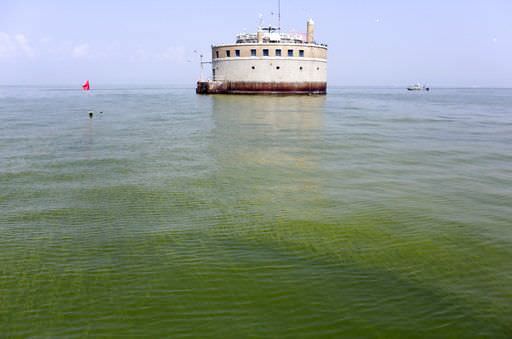Researchers Creating Warning System for Toxic Algae in Lakes
Published on by Water Network Research, Official research team of The Water Network in Technology
Satellites in space and a robot under Lake Erie's surface are part of a network of scientific tools trying to keep algae toxins out of drinking water supplies in the shallowest of the Great Lakes.

This Sept. 1, 2015, file photo shows a warning sign for algal toxins on a beach in Maumee Bay State Park, located on Lake Erie in Oregon, Ohio. Researchers are working on creating an early warning system that can spot when algae begins showing up on hundreds of lakes across the U.S., using real-time data from satellites that already monitor harmful algae hotspots on Lake Erie in Ohio and on the Chesapeake Bay along the East Coast. (AP Photo/Haraz N. Ghanbari, File)
It's one of the most wide-ranging freshwater monitoring systems in the U.S., researchers say, and some of its pieces soon will be watching for harmful algae on hundreds of lakes nationwide.
Researchers are creating an early warning system using real-time data from satellites that in recent years have tracked algae bloom hotpots such as Florida's Lake Okeechobee and the East Coast's Chesapeake Bay.
The plan is to have it in place within two years so that states in the continental U.S. can be alerted to where toxic algae is appearing before they might detect it on the surface, said Blake Schaeffer, a researcher with U.S. Environmental Protection Agency.
"You don't have to wait until someone gets sick," said Schaeffer, one of the leaders of the project.
Across the nation, farm runoff, sewage overflows and lawn fertilizers have washed into lakes and rivers and left behind unsightly algae blooms that can sicken people and pets and harm wildlife.
But often the first reports of harmful algae on a lake come from boaters seeing something strange in the water, said Rick Stumpf, of the National Oceanographic and Atmospheric Administration.
He began using satellites in 2008 to monitor algae on Lake Erie. That work took on a new urgency after a bloom near Toledo's shoreline contaminated the drinking water for more than 400,000 people three years ago.
The EPA in recent years has been testing using the satellite data to watch for algae in lakes in California, Vermont, New Hampshire, Massachusetts, Connecticut and Rhode Island.
Earlier this year, the data helped detect an algae bloom in a Utah Lake near Salt Lake City before officials on the ground knew about it.
"That's exactly what we we're trying to accomplish," Schaeffer said.
The system in development will cast a wider net at a time when many states can't afford to monitor every lake threatened by harmful algae. The goal is to use the satellite data to watch for algae on 1,800 lakes across the nation and provide four different types of water quality measurements on close to 170,000 lakes.
Read more: Phys.org
Media
Taxonomy
- Technology
- Water Quality
- Ecosystem Management
- Water Monitoring
- Ecosystem Management
- Algae
- Lake Management
- Algae Treatment
- Monitoring Technology